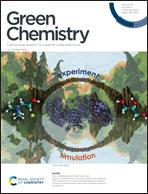Green Chemistry

Brief Name:
GREEN CHEM
Impact factor:
9.3 (2023)
ISSN:
1463-9262
Open Access:
No
Publisher:
Royal Society of Chemistry
Publication Frequency:
Bimonthly
Article Processing Charge:
£2,750
Publication Start Year:
1999
Annual Articles:
944
Self-citation Rate:
7.5%
Chinese Academy of Sciences SCI Journal Classification:
| Major category | Minor category | TOP journal | Review journal |
|---|---|---|---|
Q1 CHEMICAL |
CHEMICAL COMPREHENSIVE | Yes | No |
Subject Classification:
CHEMISTRY, MULTIDISCIPLINARY
CiteScore:
| CiteScore | SJR | SNIP | CiteScore ranking | ||||||
|---|---|---|---|---|---|---|---|---|---|
| 16.1 | 1.878 | 1.599 |
|
H-Index:
186
SCI Index Status:
Science Citation Index Expanded
Official Review Time:
Time to first decision (peer reviewed only): 35 days
PubMed Central:
Submission Site:
Aims and Scope:
Green Chemistry provides a unique forum for the publication of innovative research on the development of alternative green and sustainable technologies.
The scope of Green Chemistry is based on, but not limited to, the definition proposed by Anastas and Warner (Green Chemistry: Theory and Practice, P T Anastas and J C Warner, Oxford University Press, Oxford, 1998). Green chemistry is the utilisation of a set of principles that reduces or eliminates the use or generation of hazardous substances in the design, manufacture and application of chemical products.
Green Chemistry is at the frontiers of this continuously-evolving interdisciplinary science and publishes research that attempts to reduce the environmental impact of the chemical enterprise by developing a technology base that is inherently non-toxic to living things and the environment. Submissions on all aspects of research relating to the endeavour are welcome.
The journal publishes original and significant cutting-edge research that is likely to be of wide general appeal. To be published, work must present a significant advance in green chemistry. Papers must contain a comparison with existing methods and demonstrate advantages over those methods before publication can be considered. For more information please see this Editorial.
Coverage includes the following, but is not limited to:
Design (e.g. biomimicry, design for degradation/recycling/reduced toxicity…)
Reagents & Feedstocks (e.g. renewables, CO2, solvents, auxiliary agents, waste utilization…)
Synthesis (e.g. organic, inorganic, synthetic biology…)
Catalysis (e.g. homogeneous, heterogeneous, enzyme, whole cell…)
Process (e.g. process design, intensification, separations, recycling, efficiency…)
Energy (e.g. renewable energy, fuels, photovoltaics, fuel cells, energy storage, energy carriers…)
Applications (e.g. electronics, dyes, consumer products, coatings, pharmaceuticals, preservatives, building materials, chemicals for industry/agriculture/mining…)
Impact (e.g. safety, metrics, LCA, sustainability, (eco)toxicology…)
Green chemistry is, by definition, a continuously-evolving frontier. Therefore, the inclusion of a particular material or technology does not, of itself, guarantee that a paper is suitable for the journal. To be suitable, the novel advance should have the potential for reduced environmental impact relative to the state of the art. Green Chemistry does not normally deal with research associated with 'end-of-pipe' or remediation issues.
The scope of Green Chemistry is based on, but not limited to, the definition proposed by Anastas and Warner (Green Chemistry: Theory and Practice, P T Anastas and J C Warner, Oxford University Press, Oxford, 1998). Green chemistry is the utilisation of a set of principles that reduces or eliminates the use or generation of hazardous substances in the design, manufacture and application of chemical products.
Green Chemistry is at the frontiers of this continuously-evolving interdisciplinary science and publishes research that attempts to reduce the environmental impact of the chemical enterprise by developing a technology base that is inherently non-toxic to living things and the environment. Submissions on all aspects of research relating to the endeavour are welcome.
The journal publishes original and significant cutting-edge research that is likely to be of wide general appeal. To be published, work must present a significant advance in green chemistry. Papers must contain a comparison with existing methods and demonstrate advantages over those methods before publication can be considered. For more information please see this Editorial.
Coverage includes the following, but is not limited to:
Design (e.g. biomimicry, design for degradation/recycling/reduced toxicity…)
Reagents & Feedstocks (e.g. renewables, CO2, solvents, auxiliary agents, waste utilization…)
Synthesis (e.g. organic, inorganic, synthetic biology…)
Catalysis (e.g. homogeneous, heterogeneous, enzyme, whole cell…)
Process (e.g. process design, intensification, separations, recycling, efficiency…)
Energy (e.g. renewable energy, fuels, photovoltaics, fuel cells, energy storage, energy carriers…)
Applications (e.g. electronics, dyes, consumer products, coatings, pharmaceuticals, preservatives, building materials, chemicals for industry/agriculture/mining…)
Impact (e.g. safety, metrics, LCA, sustainability, (eco)toxicology…)
Green chemistry is, by definition, a continuously-evolving frontier. Therefore, the inclusion of a particular material or technology does not, of itself, guarantee that a paper is suitable for the journal. To be suitable, the novel advance should have the potential for reduced environmental impact relative to the state of the art. Green Chemistry does not normally deal with research associated with 'end-of-pipe' or remediation issues.
Submission Guidelines:
Types of Articles Accepted:
Communications
Full papers
Critical reviews
Tutorial reviews
Perspectives
Comments
Full papers
Critical reviews
Tutorial reviews
Perspectives
Comments
Reference Citations Format:
Disclaimer:
This page displays information about journals or magazines for reference and study purposes only. It is not the official website of any journal or magazine and does not involve publishing matters. Users must verify any publishing-related inquiries directly with the publisher.
If there are any issues with the content displayed on this page, please contact us at: [email protected], and we will verify and address the matter diligently.
This page displays information about journals or magazines for reference and study purposes only. It is not the official website of any journal or magazine and does not involve publishing matters. Users must verify any publishing-related inquiries directly with the publisher.
If there are any issues with the content displayed on this page, please contact us at: [email protected], and we will verify and address the matter diligently.